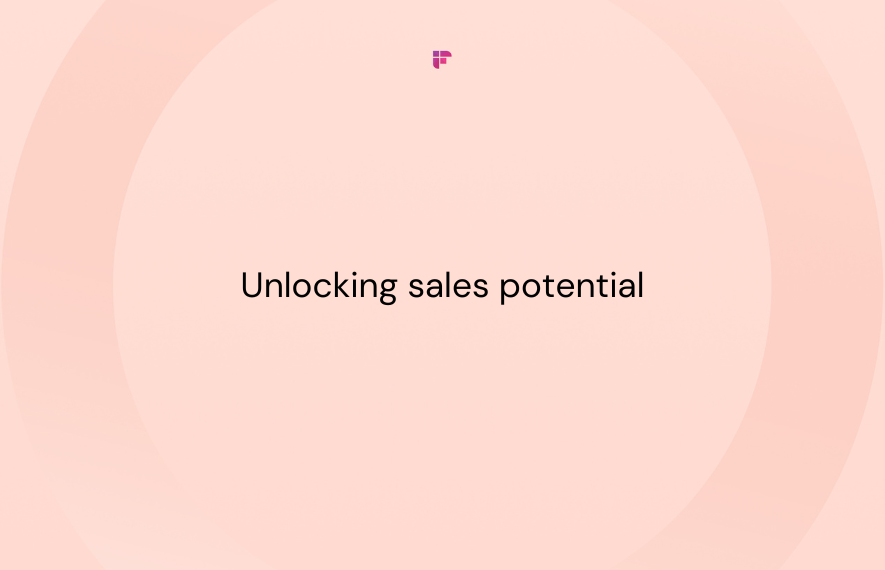Knowing how to calculate, interpret, and optimize your sales win rate is a surefire way to achieve consistent sales success.
With this important metric, you can measure the effectiveness of your team's sales outreach strategy and find areas for improvement.
In this blog post, we'll explore what a sales win rate is, how to calculate it, and how you can use it to refine your sales processes.
Let's get started!
What is a sales win rate?

A sales win rate (also known as a win percentage) represents the success rate of a sales team in converting leads into actual customers.
It's calculated by dividing the number of won/closed deals by the total number of deals pursued during the same period.
So, why is it important to know your sales win rates? Well, you can use it to:
- Identify and subsequently train underperforming reps
- Pinpoint strengths and weaknesses in your sales processes
- Determine whether you're pursuing prospects that aren't an ideal fit for your product or service
- Forecast future sales
Calculating and analyzing your sales win rates will help you make data-driven decisions to optimize your sales efforts and boost revenue.
How to calculate sales win rates
Calculate your sales win rate by dividing the number of successful sales by the total number of opportunities. Then, multiply the result by 100 to get a percentage.
Here's a simple formula:
.png)
You can also calculate your average sales win rate based on amount/revenue.
Let's say your team closes 3 out of 5 sales opportunities. According to the previous calculation, your win rate would be 60%.
However, you'll get a different result when you consider the actual deal sizes. For instance, let's imagine that:
Deal 1: $10,000 - Won opportunity
Deal 2: $10,000 - Won opportunity
Deal 3: $10,000 - Won opportunity
Deal 4: $15,000 - Lost opportunity
Deal 5: $20,000 - Lost opportunity
So, in total, your team closed deals worth $30,000 out of a potential $65,000. Here, your sales win rate would be 46.1%.
.png)
2 Tips for calculating your sales win rate
Want to ensure that your sales win rate calculation is accurate? Keep these handy tips in mind.
1. Define your reporting period
Choose a specific period for your calculations, such as a month or a quarter. A well-defined reporting period allows you to track changes over time and make informed decisions based on trends.
2. Identify your win-loss criteria
Clearly outline what constitutes a win and a loss for your sales team. For example, a win could be closing a deal or securing a new customer, while a loss might be losing a potential client to a competitor or a deal falling through.
Establishing clear criteria ensures consistency in your calculations and provides a broader view of your sales performance.
This ensures that your win rate calculations accurately reflect the current state of your sales efforts.
7 Best practices to increase your sales win rates

Improving your sales win rates requires a strategic approach focusing on understanding your customers and building strong relationships.
Here are some easy-to-implement best practices to increase your chances of closing deals successfully:
1. Nurture your leads
This involves staying connected with your potential customers in a thoughtful and personalized way.
Regularly share valuable information, answer their questions promptly, and show genuine interest in solving their problems.
Your goal should be to cultivate a relationship with your leads by demonstrating reliability and a commitment to meeting their needs.
This increases the likelihood that they'll choose your product or service when the time is right.
2. Involve and build relationships with decision-makers on time
Building strong relationships with decision-makers right from the jump will also help you boost your sales win rates.
If a sale doesn't align with a decision maker's priorities or has no serious potential, they can block it right away. While this may be initially disappointing, it'll save you from wasting time and resources.
3. Expect potential roadblocks
Anticipating potential roadblocks means taking a proactive stance to understand and prepare for any hurdles that might pop up during the sales process.
Not only will this ensure that you're not caught off guard, but it'll also push you to try and develop solutions to these challenges.
Apart from objections in decision-making (which we mentioned in the last point), other roadblocks may include unexpected budget constraints and changing customer priorities.
4. Establish clear timelines
Clearly defining timelines throughout the sales process is crucial for managing expectations and creating a smooth customer experience.
Think of your sales journey as a roadmap with distinct stops – from the initial contact to the final deal.
Setting specific timeframes for each stage creates a shared understanding with your potential client about what to expect and when.
For example, you should let your clients know when they can anticipate a proposal after an initial meeting, when a demo will be scheduled, or when a decision is expected.
5. Don't make assumptions
One of the crucial pitfalls to avoid in sales is making assumptions about what your customers want or need.
Instead of relying on guesswork, take the time to actively listen and understand their specific situation.
This will help you tailor your solutions to their requirements and increase your chances of selling successfully.
6. Invest in continuous training
Provide ongoing training to keep your sales team updated on industry trends, product knowledge, and effective sales techniques.
A well-trained team will be more confident, adaptable, and better equipped to handle diverse customer needs.
7. Score leads to discover high-potential opportunities
Implement a lead scoring system to prioritize and focus your efforts on leads with the highest potential.
Understanding which prospects will likely convert will help you allocate resources efficiently and improve your win rates.
Use Fireflies to improve your sales win rates

Need a tool to impact your sales win rate and drive success positively? Fireflies is just what you're looking for!
Fireflies is an AI-powered notetaker and Conversation Intelligence tool that can provide helpful insights into your sales meetings and customer interactions.
With these data-backed insights, you can properly understand the dynamics of successful sales, identify areas for improvement, and track your progress over time.
Let's check out Fireflies' features in more detail:
1. Transcribes and summarizes your meetings
Fireflies joins your meetings as a participant and automatically helps you generate transcripts so you can focus on the discussion instead of scrambling to take notes.
Plus, these transcripts are over 90% accurate and can be generated in over 60 languages!
Fireflies also provides customizable and straight-to-the-point summaries of your sales conversations with outlines, bullet-point notes, action items, clickable timestamps, and more.
With these transcripts and summaries, you can take note of customer pain points, objections, and other critical information that will help your team sell better.
2. Provides meeting analytics
Fireflies' Conversation Intelligence features will help you unlock meeting insights, analyze sales trends, and track topics and the quality of your team’s conversations over time.
Using over 10 metrics, you can coach your reps and replicate best practices to create a high-performing sales team.
Some of these metrics include sentiment, silence duration, average talk-to-listen ratio, and total number of filler words.
3. Enhances onboarding, training, and collaboration
With Fireflies' soundbite feature, you can easily highlight and collaborate on the most critical parts of your meetings.
You can even organize these soundbites into playlists and develop comprehensive sales playbooks outlining best practices to help your team close more deals.
Share these playlists with your team and make your training/onboarding processes a walk in the park!
Another collaborative feature of Fireflies is Threads; it allows you to add, reply, and edit comments in your transcripts so you can leave feedback for your team.
4. Stores your meetings
Fireflies stores and organizes all your meetings and transcripts in a centralized location: Notebook.
In your Notebook, you can search through all your meetings and get more information about the date and duration of the meeting at a glance!
Search all your meetings to find out what was discussed days, weeks, or months ago. Fireflies Notebook provides your team with a dynamic and searchable knowledge base of your conversations, which you can revisit anytime and anywhere.
5. Lets you search your meetings
You can also search specific keywords, mentions, phrases, topics, or speakers in your transcript.
With Smart Search features like AI Filters and Topic Trackers, Fireflies highlight important sections of your meeting to help you quickly retrieve key information.
The AI Filters provide crucial meeting details, such as dates and times, action items, pricing questions, and tasks.
Also, by using Topic Trackers, you can create custom phrases and keywords specific to your industry or domain to further streamline your search.
5. Logs meetings and transcripts
Let's face it—manually logging sales calls into your CRM can be a time-consuming task for your reps.
That's why Fireflies integrates with your CRM to automatically log your calls and transcripts to the appropriate contacts!
This automation ensures timely data entry and effective follow-ups, allowing your team to focus more on driving sales.
Aside from CRM tools like Freshsales and Salesforce, Fireflies integrates with 30 other tools, including web conferencing, productivity and calendaring apps.
6. Provides a helpful AI assistant
It also offers a ChatGPT-like assistant called AskFred that can answer any questions about your sales conversations to recall crucial information.
You can also use it to write follow-up emails, generate blog ideas, and write reports.
AskFred significantly boosts productivity and facilitates smoother post-meeting workflows for your team.
7. Secures your meetings
With Fireflies, you don't have to worry about security breaches, as Fireflies.ai is highly committed to protecting your meeting data.
It keeps all your data encrypted at rest and in transit and is SOC 2 Type II, HIPAA, and GDPR compliant.
Fireflies also offers private storage to provide you with dedicated and isolated data storage for your organization.
Effortlessly boost your sales win rates using Fireflies.ai
This meeting tool provides actionable insights that you can use to refine tactics, train your team, and achieve sales excellence.
💡 Effortlessly boost your sales win rates using Fireflies.ai
This meeting tool provides actionable insights that you can use to refine tactics, train your team, and achieve sales excellence.
The takeaway
Now that you know how to calculate and optimize your sales win rate, you can effectively fine-tune your sales strategies and propel your business to new heights.
Remember — it's not merely about the numbers. It's about using those numbers to assess your team's performance and help them close more deals.
And, the best part is, you don't have to embark on this journey alone.
With its AI-powered conversational intelligence and meeting transcription capabilities, Fireflies provides valuable insights to improve your sales performance!







